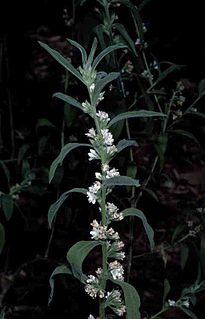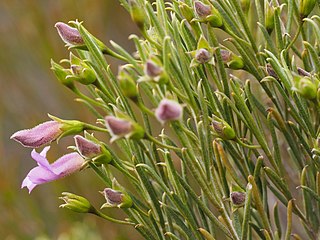Diocirea is a genus of flowering plants in the figwort family, Scrophulariaceae. The genus is endemic to a small area in the south-west of Western Australia and is intermediate in character between Eremophila and Myoporum. There are four members of the genus, all of which are small shrubs with stems and leaves which produce a resin making the plants appear bluish-green. Neither the genus, nor any of the species had been described before 2007 although a few specimens had been collected as Eremophila elachantha. Despite their limited distribution, they often occur in populations of several thousand individual plants, forming a dense ground cover.

Myoporum velutinum is a plant in the figwort family, Scrophulariaceae and is endemic to a small area near Esperance in Western Australia. It has similar flowers and fruits and grows in similar environments to Myoporum tetrandrum but differs from it and all other members of the genus by having hairs on the outer edge of the petals.
Glycocystis beckeri is the only species of the flowering plant genus Glycocystis in the family Scrophulariaceae and is endemic to the south west of Western Australia. It is a shrub, similar to others in the genera Eremophila and Myoporum but is unusual in that it produces very large amounts of sticky, sweet-smelling resin produced by raised glands which cover the entire plant, except for the petals. It has been suggested that the resin traps insects which the plant uses as a source of nitrogen.

Diocirea microphylla is a plant in the figwort family (Scrophulariaceae), and is endemic to a small area near Coolgardie in Western Australia. It is a low shrub with thin branches and minute leaves pressed against the stems. It is readily distinguished from the other three species in the genus by its tiny leaves.
Diocirea ternata is a plant in the figwort family, Scrophulariaceae and is endemic to a small area near Balladonia in Western Australia. It is a low shrub with a restricted distribution but which often occurs in large numbers, forming a dense ground cover. It is readily distinguished from the other three species in the genus by its unusual leaf arrangement.
Diocirea violacea is a plant in the figwort family (Scrophulariaceae), and is endemic to a small area near Salmon Gums in Western Australia. It is a low shrub with a restricted distribution but which often occurs in large numbers, forming a dense ground cover. It can be distinguished from the three others in its genus by a combination of the size and arrangement of its leaves and the appearance of its fruits.
Eremophila appressa, commonly known as wispy poverty bush, is a plant in the figwort family, Scrophulariaceae and is endemic to two remote locations in the central west of Western Australia. Its most unusual feature is its leaves which, at least when young, are less than 2.5 mm (0.1 in) long and 1 mm (0.04 in) wide and are glued to the stem by resin.
Eremophila coacta is a flowering plant in the figwort family, Scrophulariaceae and is endemic to a small area in the north west of Western Australia. It is an erect shrub with narrow, sticky, pointed leaves and densely hairy light to dark lilac-coloured flowers.
Eremophila cryptothrix is a flowering plant in the figwort family, Scrophulariaceae and is endemic to the Pilbara region of Western Australia. It is a shrub with sticky stems due to the presence of resin, narrow leaves, coloured sepals and white, pale pink or pale blue flowers.

Eremophila galeata is a flowering plant in the figwort family, Scrophulariaceae and is endemic to Western Australia. It is a shrub with sticky, shiny leaves, unusual sepals, a dull pink and brown, spotted petal tube and which grows in stony red soils.

Eremophila labrosa is a flowering plant in the figwort family, Scrophulariaceae and is endemic to Western Australia. It is a shrub with many hairy branches arising from near ground level, narrow, hooked leaves and mauve and blue flowers.
Eremophila lucida, commonly known as shining poverty bush, is a flowering plant in the figwort family, Scrophulariaceae and is endemic to Western Australia. It is an erect shrub with sticky, shiny leaves and branches and with flowers that are either red with darker red blotches inside or cream-coloured without spots or blotches.

Eremophila mirabilis is a flowering plant in the figwort family, Scrophulariaceae and is endemic to Western Australia. It is a shrub with narrow leaves, brightly coloured sepals and petals growing in two widely separated areas.
Eremophila papillata is a flowering plant in the figwort family, Scrophulariaceae and is endemic to Western Australia. It is an erect, compact shrub with sticky, narrow leaves and mauve, blue or purple, rarely white flowers.

Eremophila parvifolia is a flowering plant in the figwort family, Scrophulariaceae and is endemic to Australia. It is a shrub which has small, usually egg-shaped leaves and blackish flower buds which open to purple flowers which are white with purple spots inside. There are two subspecies, both of which are found in Western Australia and one which is also found in South Australia.
Eremophila pendulina is a flowering plant in the figwort family, Scrophulariaceae and is endemic to Western Australia. It is a tall, spindly, weeping shrub with narrow leaves and purple, mauve or white flowers in autumn and early spring.
Eremophila petrophila is a flowering plant in the figwort family, Scrophulariaceae and is endemic to Western Australia. It is a tall, erect, open shrub with rough branches, narrow, sticky leaves and pale lilac-coloured flowers.

Eremophila purpurascens, commonly known as purple eremophila, is a flowering plant in the figwort family, Scrophulariaceae and is endemic to Western Australia. It is an erect, bushy shrub with warty leaves and spotted, pink to red flowers.
Eremophila succinea is a flowering plant in the figwort family, Scrophulariaceae and is endemic to Western Australia. It is an erect, broom-shaped shrub with sticky, narrow, hooked leaves, narrow, sticky sepals and hairy, pale purple or mauve petals.

Eremophila veneta, commonly known as metallic-flowered eremophila is a flowering plant in the figwort family, Scrophulariaceae and is endemic to Western Australia. It is a low, spreading, sticky shrub with dark green leaves and bluish-green petals.








